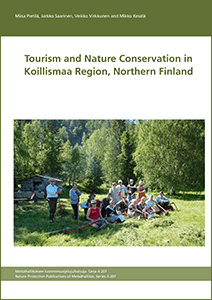Tourism and Nature Conservation in Koillismaa Region, Northern Finland
In order to promote sustainable regional development, inclusion of local communities in natural resource management concerning their living environments is vital. Acknowledging residents’ current attitudes towards tourism and nature conservation, as well as the possible changes in these attitudes, is important to enable proactive reactions to these changes. This study was conducted to find out how local people in Northeastern Finland (Koillismaa region) perceive tourism and nature conservation to affect their living environment and their everyday lives.
The study was implemented as a postal survey in December 2013. Altogether 592 residents living in Koillismaa region responded to the survey. The study was carried out applying the research design used in a study carried out in the area in 2002‒2003. The data of the previous study was used as a secondary data in this study. Survey data were analysed using statistical methods: presenting key figures and relative frequencies of findings.
In Koillismaa, the responding residents perceived tourism to be an altogether positive thing and residents were willing to further develop tourism industry and to increase the amount of tourists. The core tourism destinations Ruka and Syöte were assessed to benefit most from tourism. Tourism was considered to affect positively on regional economy through increasing employment and improving services and infrastructure. Physical environment was considered to suffer most from tourism due to pollution, littering and degradation of the environment. Residents felt that they had been moderately taken into account in tourism planning, but majority of residents seemed though to be satisfied with their possibilities to participate in tourism planning.
Koillismaa residents considered nature to have immaterial value and that nature should be conserved for future generations. Residents perceived nature conservation to impact positively on the beauty of the scenery, the enjoyment of the area and the diversity of nature as well as to promote tourism. Nature conservation was considered to cause limitations to everyman’s rights and to commercial uses of the land. The attitudes towards tourism and nature conservation had remained the same or slightly improved during the past ten years.
Residents’ attitudes against tourism and conservation were not unanimous. Residents living in Ruka area were more supportive of tourism and nature conservation than residents living elsewhere, especially in Northern Kuusamo. Younger and highly educated residents reacted on average more positively to conservation and tourism than the others.
This study encourages to further develop tourism in Koillismaa region. Nevertheless, more attention should be paid on the environmental issues to guarantee sustainable development. In addition to contextual information, this study gave valuable experiences on how the monitoring of residents’ attitudes should be carried out in the future.
